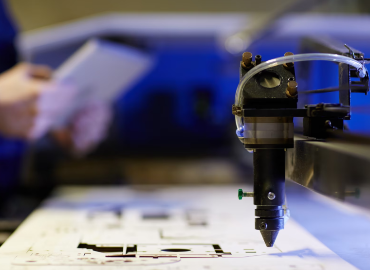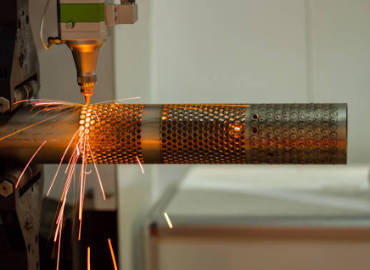Today, in this article, we will discuss the "Laser Welding Machine". Laser welding machines, as well as laser welding technology, are becoming extremely popular with time and with the inception of the latest laser production technologies. In simple terms, laser welding can be defined as the process of combining metallic substances or thermoplastics with the help of a laser beam.
Though, when compared to other traditional welding procedures, laser welding is way ahead and is able to finish the given task in a short period of time.
Interestingly, there are multiple advantages of laser welding technology over traditional methods of welding technologies. We have listed down some of the advantages of laser welding machines that one will receive while using them. Let's have a look at the benefits given below.
Advantages Of Laser Welding Machines
The integration of laser welding is simpler with automation and Computer support systems. This way, it provides you with control over the complete process as well as helps in making the operation super accurate and productive.
The other elements or tools are not at all affected during the entire welding procedure.
The concentration of the laser beam is remarkable. Hence, the final weld tends to have superior quality and is durable for a really long time.
When a comparison is drawn between the traditional welding techniques & laser welding technique on the basis of speed, laser welding technology comes out with flying colours as the speed of the welding process is really high. This feature makes the laser welding technology acceptable & favourable for batch generations.
Laser welding technology is favourable to the commodities that are in need of a high level of accuracy, just like in the process of manufacturing medical products.
The intake energy is much lower than that utilised in various other types of welding methods.
After the welding is done, no secondary finishing of the products is required. Therefore, it results in preserving the time in welding and the workforce.
Basically, it's a contactless technique which signifies that there are no contacting aspects, and consequently, the quality & traits of the finished product and the lifespan of the machines will be much better.
Though we can say that there are no such disadvantages of laser welding technology, still there are a few things that need to be addressed or taken care of at the time of implementing the method on an industrial scale.
It is obvious that laser welding techniques cannot be done by anyone, one has to gain a specific amount of skill and knowledge to achieve the given task.
In case if the job is attained by someone who is not familiar with & aware of the laser welding techniques, then the finished product will have to suffer. The ultimate result will not be the same as desired.
There are a few events where lack of knowledge or experience about the techniques comes into play are mentioned below:
Detailed knowledge of the business, the task and the type of laser that has to be used is essential for the person who will be functioning on the laser welding system.
The most important thing for the technicians is to remove the air pockets because if the air pockets remain constant during the entire welding procedure, then the quality of the weld may depreciate a little and will not be durable enough. Also, for your information, this particular problem takes place only in the pulse laser welding technique.
The laser heat should be applied evenly on the surface of the material during the process of the laser conduction welding technique.
So, if the laser heat is not appropriately applied on the surface, then it may lead to uneven welds, which can develop reliability & trust difficulties in the near future.
Lastly, you need to be extra careful when you are welding on optical surfaces because they tend to get harmed easily.
Besides, the preliminary investment incorporated in laser welding machines is somewhat more huge than the other welding techniques. Additionally, the cost of the maintenance of the machine is also huge, if only when it creates any problems at the time of operation.
Is Laser Welding Stronger Than Tig Welding?
Laser welding is much better & decent when compared to Tig welding(also known as conventional welding), and hence, helps to eliminate the risk of contamination. It’s also more accurate, simpler to automate, and delivers positivity for bonding of much thinner metals, and also provides great tensile and bending stability & strength at the same time.
If arc welding is generally part of your product manufacturing method, then you may need to consider laser welding rather. Arc welding needs a filler or a bonding material to combine two pieces of metal, whereas laser welding builds a straight metal-to-metal bond, and there is no requirement for a filler. Unlike with arc or torch welding, there’s no slag which means excess filler that has dissolved and hardened in & around the weld, to grind off afterwards or left behind to potentially infect the environment in which the application has to be done. This is especially significant in applications like dental, medical, and scientific tools where you don’t want pieces of substance falling apart and causing harm to people or delicate equipment.
Two Types of laser welding
Laser welding can be performed in two manners; the first one is Heat conduction welding, and the second one is keyhole welding.
a) Heat conduction welding: In this process, the metal surface is heated above the melting point of the metal, but not to the extent that it evaporates. This process is used for welds that do not need high weld strength.
The hot conduction welding comes with an advantage, i.e. the finished weld will be super smooth and aesthetical. For heat conduction welding, a low power laser in the range of <500W is used.
b) Keyhole welding: In this procedure, the metal is heated up by the laser beam in such a way that it results in the contact surface vaporising and scouring deep into the metal. This way, a keyhole is created, and there a plasma-like circumstance develops, making the temperature rise up to 10,000K or even more.
Transform Your Welding Process - Explore Our Air-Cooled Handheld Laser Solutions!
How Much Does A Laser Welding Machine Cost?
In this competitive world, companies need to lower the prices and work on the efficiency and the quality of the product. However, relying on high-performance fibre lasers, which do not require any maintenance, has made the laser welding technology the most suitable & preferred welding solution for the process of manufacturing metals. To weld, the complex part without causing any harm to the substance can be done by making use of a fibre laser welding machine.
However, portable handheld laser welders can sell for a cost spectrum of $7,400 to $12,100. But you need to understand that prices may vary broadly depending on the configurations of the welder.
Also, the cost of laser hand-held welding devices is also connected with the brand name of the product. There are numerous laser welding machine producers all over the nation, and actually, the quality of each of their products can differ slightly. The cost of laser welding machines with a good brand name will automatically cost higher than other ordinary brands. Small workshops may not offer after-sales facilities, but when it comes to good brands, they will have this kind of service for their customers. The quality and integrity are ensured & safeguarded by the manufacturer, and the after-sales assistance is absolutely wonderful. One should always look for a good brand when thinking about purchasing such kinds of machines.
Conclusion
Laser welding machines provide excellent high-speed metal welding solutions for modern & progressive manufacturing processes in so many metal industries. Also, in the past few days, laser welding technology has evolved and is highly credible & an easy automated process that intends to deliver the highest part quality at a really low tooling cost and it doesn't require much care & maintenance.






